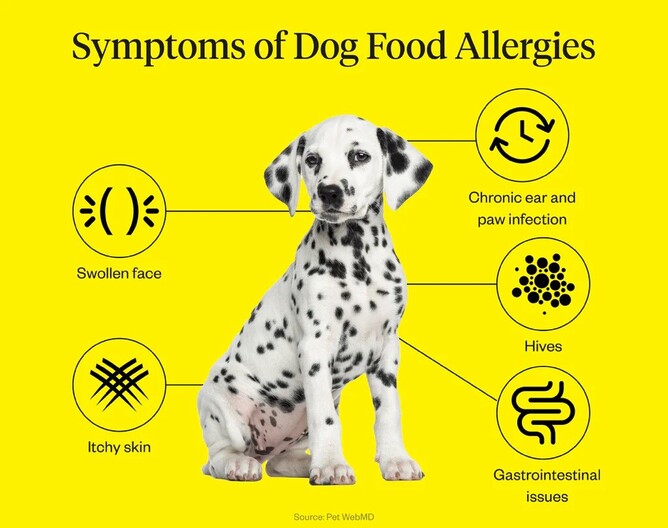The most recent studies show that the most common food allergens in dogs are wheat, beef, chicken and dairy products while in cats it’s chicken, beef, and fish (Muller and Olivry 2016). If you wanted to save yourself the read, the advice is thus very simple – if your dog is exhibiting recurring skin or gut conditions then it’s highly likely they have a food intolerance. Thus, before a drug is taken or a cream applied, you need to remove at least these problem proteins from your pet’s life.
Wheat is the number one cause of food intolerance in dogs
Far and away the most common factor aggravating dogs worldwide is wheat. I believe it explains up to 80% of cases reporting into us daily.
The problem with wheat is that tough little protein called gluten. Gluten is a tough, long-chained molecule, something like a necklace of beads. It gives dough its stretchability and it permits you to spread peanut butter on what should be a very flimsy piece of bread. It’s the base of some of the worlds best glues (from where it gets its name). A side effect of this amazing property is that it’s very hard to break down in the gut. 30% of humans still can’t digest it properly. The longer you have been eating it the better you are at digesting it. Hence Europeans who have been farming wheat for years are pretty good at digesting wheat. Only 20-30% of Europeans suffer gluten intolerance. However Africans farm and eat gluten-free cereals such as sorghum and millet. As a result of the slave trade 400 years ago we now find that 40% of African-Americans suffer the effects of gluten intolerance in the US. Aboriginals were only introduced to wheat 100 years ago and 50% are known to be gluten intolerant.
We’re omnivores, adapted to eating plant forage, with long, slow digestive systems and appropriate microflora. Your dog is a carnivore. With a rapid digestive system and a microflora completely unadapted to plant food, he is terrible at digesting plant forage, and they have only been eating wheat for 50 years!
Since 1944 we have known that gluten is not the easiest protein for dogs. Wagner and Elvehjem (1944) documented how doses of up to 40% gluten induce fits or “canine hysteria” in beagles. In 1992 Batt and Hall noted that biopsies of intestinal segments showed that dogs sensitive to gluten suffered villus atrophy accompanied by increased intestinal permeability, which improved with a gluten-free diet and relapsed on subsequent gluten challenge. Today coeliac disease is evident in Irish red setters (Hall and Batt 1991 & 1992), gluten allergy is thought to affect at the very least 1% of the canine population (Loft et al. 1989, Hall et al. 1992, Day 2005), it plays a key roles in issues such as protein-losing nephropathy in soft-coated wheaten terriers (Littman and Giger 1990, Littman et al. 2000, Vaden et al. 2000a & 2000b) and Day (2005) admits that it is likely delayed sensitivity to gluten is responsible for many more disorders and affecting many different breeds.
The very same applies to dairy, at least cows milk. With milk, the problem protein is casein, which is very similar to wheat gluten. So cut out all dairy initially also.
To avoid the symptoms of food sensitivity please ensure that your dog is never fed wheat. This means no dog food that contains any wheat (check your ingredients). Also no bread, pasta, no dental sticks, no cereal based dog treats. Not a crumb. It is the number one cause of food intolerance in dogs and it’s removal cures the majority of cases reporting to us. And moving to a wheat free dry food is not enough. Studies of these dry foods show that 10 of 12 studied were contaminated with proteins not on the label, mostly wheat gluten
Second is chicken and beef…
You might wonder, as I did for years, how carnivores could be allergic to such an appropriate food source as chicken, beef or fish. The truth is dogs are commonly shown to have a problem with chicken and beef, just not the normal kind we eat ourselves. This chicken or beef is present in a heavily processed form in dry food. Harsh cooking severely denatures animal protein (think a fresh egg to a fried egg) and as a result, cooked meat is harder to digest than fresh (think overcooking a fresh piece of steak). The human food chain produces a huge amount of chicken and beef by-products and waste. These are all rendered (boiled under pressure) down so that the fat floats to the top and the protein sinks to the bottom. This grey protein goo off is taken off the bottom of the vat, dried to form a flour and is then sent to pet food companies all over the world as the “meat” portion of many animal feed products. These manufacturers then cook this product again at high temperature before being bagged and leaving it sitting in a storehouse for months (or years).
Unfortunately, cooking causes structural changes in the protein known as cross-linking, a process whereby the individual proteins (called amino acids) hold hands, forming a chain and giving that over-cooked piece of steak it’s toughness. Add to this that cooking destroys all the natural enzymes in meat that would have been released when the fresh stuff was chewed up, means the “meat” portion of dry food is some very hard to digest stuff. Hence Stroucken et al. (1996) found cooking during the extrusion of dog food pellets reduced the digestibility of protein in the pellet.
By the time this partially-digested “chicken” or “beef” reaches the dog’s intestines it does not resemble real chicken and beef. The immune system does not like these strange little strands of protein and can begin to react to them. Sadly, once this process occurs the immune system can identify even the fresh form of the problem protein as causing a problem. This can result in a dog having a chicken or beef sensitivity, which should be as unusual as a cow being allergic to grass.
third Food Chemicals and Additives
It will be almost impossible to find out which food chemical is irritating your dog. A short nutritional rule is if you can’t pronounce it don’t feed it. With more agents than the FBI, pet food manufacturers are permitted by the FDA to include anti-caking agents, antimicrobial agents, curing, drying and firming agents, oxidizing and reducing agents, pH control agents and surface active agents. Other chemicals such as synergists and texturisers, emulsifiers, humectants, and stabilizers control the exact texture of the pellet. One of these texturisers, a thickener called sodium carboxyl-methyl-cellulose a plastic filler which used to be used to thicken milkshakes is banned by the FDA for human consumption…but it’s OK for pet food. Then there’s BHA and BHT and Ethoxyquin. A nasty group of fat preservers these, already well covered by other authors. A quick Google will quickly let you know why you should absolutely avoid these in your diet.
What Are Dogs Allergic To, In Summary
If you keep putting the above antigens (wheat, cooked meat, chemicals) in to your dog you will continue to get problems on the surface. Again think of a man with a peanut allergy being fed small amounts of peanut each day. As long as you do this you will need to continually focus on the symptoms with expensive pills, jabs and creams, all of which are telling the immune system to quit trying to purge the body of toxins.
The above need to be cut out completely. Not a speck.
What to do
Now That You’re Getting to Grips with the Cause of Your Dog’s Predicament, What Does a Hypoallergenic Dog Food Look Like?!
Now that you understand what to take OUT of the diet in order to alleviate the symptoms of what you are seeing on the surface, next you need to know what to put IN to the diet to both repair and nourish him in the future.
Enter hypoallergenic dog food. Hypoallergenic essentially means very unlikely to cause a problem in your dog. It’s important to rehighlight what you learned in section 1 here and that is single protein dry foods, often sold under the pretence of “hypoallergenic” (despite having hundreds of ingredients and chemicals!) are absolutely not recommended. Ricci et al. (2013) looked at 12 limited ingredient commercial foods intended for use in food elimination trials for dogs with adverse food reactions. Ten of the 12 foods studied contained ingredients of animal and fish origin that were not listed on the label.
A dry, ultra-processed diet is likely the cause of your dog’s issues and a fresh, homemade raw dog food is the only answer. We’re going to keep it really simple as we don’t yet know which proteins might be causing him problems. We are going to feed him a simple, hypoallergenic dog food, one made on fresh meat, bone and some veg. From that point, we will carefully conduct an exclusion diet, this is the process of cycling carefully through each meat protein over time, asking the body what it is OK with and what it doesn’t like. This is a cheap and easy but highly definitive way of finding out exactly what is bothering your dog and what to avoid in the future. And, needless to say, he is going to ADORE his new meat-filled regime.
Note: It is important to keep up whatever pills you have been prescribed for the short term and please finish any courses of antibiotics that your vet has invariably prescribed up to this point. You can start very slowly coming off steroid or NSAID tablets from day 3. Slow is key, for example if on one tablet, reduce by a quarter every two days. We don’t know where we are as long as these tablets are in there shutting the immune system off. It’s our warning simple. We’re now going to work with the body, which is the correct road to recover.
Picking the Right Protein to Start Off With is Crucial…
We need to find a safe meat protein that works for your dog. You have three options to determine this:
You no doubt have been making a mental list of all the stuff that hasn’t been. So have a good think there, is there a meat that doesn’t cause his issues? Turkey? Duck? Rabbit? Lamb? Unless you know they’re OK we usually leave out chicken or beef as so many dry foods are based on these proteins. If his gut is shot there is a chance it’s leaky and if that’s the case we might be sensitive to that protein (and many other proteins that were in the mix, on purpose or otherwise). If you know one or two options then you start with them. That’s your hypoallergenic diet. Simple as that.
Many of you may already have conducted a food allergy test and you’re sitting there with a NASA-esque list in your hand of possible food allergens in your dog. These tests have issues but still if the protein is NOT on that list, it’s a good place to start.
If you want to wing it, which is very doable, simply pick a meat that you think your dog hasn’t had yet. Duck? Lamb? Goat?! Rabbit?! Wallaby?!
Picking Your Meats…
You are going to begin by making a broth. This means you need meat and bones from that same animal. So, a broth of all turkey bits, or lamb, or pork, etc.
For the meats you want the good stuff. Best you can afford. Organic if possible (it just eliminates more potential issues). But it’s not vital. You are looking for meat on the bone as you are about to make bone broth with it.
To make a turkey broth you could simply go out and buy a whole organic turkey (ideally with all the giblets inside). You would roughly chop it up and away you go. Or a whole duck.
To make 5kg of lamb mix: Pick up 3kg of lamb necks (3kg), 1kg og lamb hearts (1kg) and 1kg of lamb tripe (1kg). If you can find a little lamb liver (250g) pop that in too.
If you wanted to make 5kg of a duck mix, you’d pick up 2kg duck carcass (add in a bag of duck feet, duck gizzard and duck wings while you’re there too!).
The above diets are simple, nutritious. We are hoping the very first one we try works, he eats is and he doesn’t have any of his symptoms. We want a few weeks of good health before we move on. However, it might not work first time, be ready for that. I usually tell folk to get two types of meat. Work with one and have the te not always the case. Prepare yourself for that. hypoallergenic diet for your dog as we can get at the moment (meaning they’re unlikely to cause a reaction). They are also infinitely better than any dry food and easily half the price. Remember every patient is different so one diet may work well for some and not for others, it’s the nature of the disease.
Bits You can add to help settle and soothe their troubled gut…
Try not to add any other food ingredients at this time as it may fudge the results, but a couple of natural supplements might help here.
First is good quality omega 3 (you want the refined stuff, high in EPA & DHA). If he has gut problems you can add some chamomile for digestion (make a strong cup of tea and add a few tablespoons to your broth) and some slippery elm which helps restore his gut lining.
Canine Probiotics. Your dogs gut flora is going to be in complete disarray and they run the show in there. Pick up canine probiotics (don’t use human ones, we eat different food).
Colostrum is the yellow liquid that comes before breast milk. It is full of goodies that can help repair your dogs damaged gut lining, most notably here is a whole lot of IgG and growth factors.
Certain supplements can help strengthen the gut lining, such as l-glutamine which is an amino acid that occurs naturally in your body and is synthesised in your muscles. It has a range of functions but studies show it plays a crucial role in healing the gastro-intestinal tract.
Make sure they’re getting chlorine-free water for the whole process…
Water from your tap contains chlorine and chlorine is there to kill bacteria. Your gut flora will be washed in the very same “disinfectant” and are not going to appreciate it. Thus, as an extra special step, consider what water you are giving him. Rainwater is good. Distilled water (boiled and cooled) another. Filtered water is better but not all filters remove chlorine.
Dr Conor Brady



